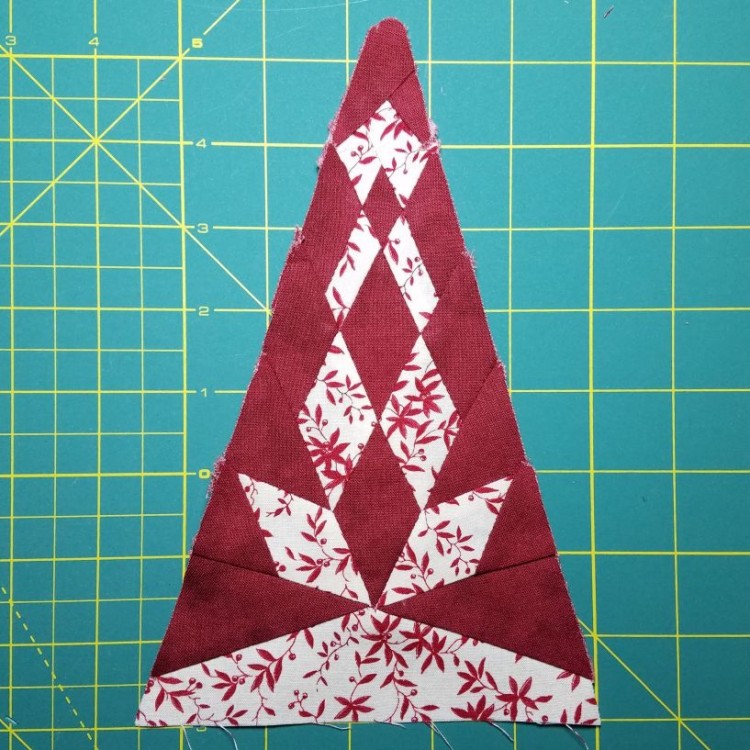Now that I’ve used all the fabrics at least once, it’s time to repeat a fabric for the first time. And what better fabric to repeat than this one, which is used in a whopping 20 blocks?
Paulette had chosen to lay out the fabrics in her quilt design so that they formed concentric rings of color – basically a Trip Around the World pattern. Some of the rings used a variety of fabrics, all in a similar color range. In others, she used the same fabric for each block in the ring – that’s how we ended up with almost 10% of the blocks slated for this particular white fabric with red leaves.
I’m not sure why she decided to have some rings be scrappy and some not, but I think it gives it a quirky twist. It’s kind of boring if all the rings are the same, and in a scrappy quilt, where all the fabrics are randomly chosen, the ring that is not made of random fabrics is the one that is different. That inconsistency is unexpected, and that’s what makes it fun.
In addition to choosing this fabric, I wanted to be sure to choose a triangle block. I’ve got almost 150 blocks left to do, and almost 50 of them are triangles. It’s no secret that I’m not a fan of the triangles, and I know that if I leave them all until the end, I’ll never finish the quilt. So, to space them out appropriately, I need to do a triangle every third block or so.
I’m psyching myself up to do my first advanced difficulty triangle (ugh!), and this one seemed fairly advanced for an intermediate difficulty block, so I thought it would be a good way to work myself up to the more advanced ones.
As a bonus, this one had a lot of small red pieces, so I was able to use up some of the leftovers from my first chunk of red fabric. You may recognize this oddball leftover piece from a few months ago (which netted me three pieces for this block):
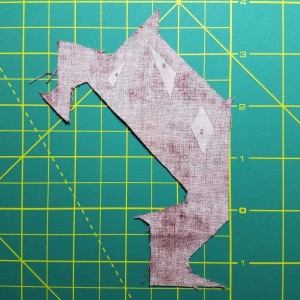
To add to the excitement, I thought I’d redraft this block. I’ve been known to eliminate a seam here and there, but I don’t do a lot of large-scale redrafting. In this case, however, one simple change eliminated all the inset seams, and the unnecessary seams going across the middle of those two white diamonds in the center. The image below shows the redrafting I did; the zigzag lines are seams I eliminated, and the dotted lines are new seam lines I added:
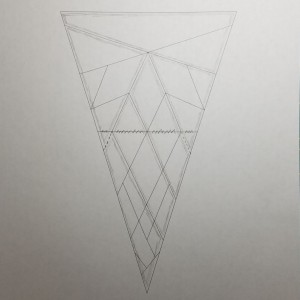
As I’ve done with most of the triangles so far, I used the Avery label technique, so the next step was to transfer my drafting changes to the pattern pieces. Since the pieces are printed out on one giant label, I simply drew the changes on to the label before cutting out the individual pieces:
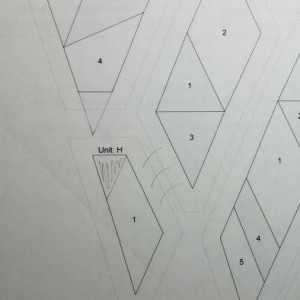
The pattern looks very complicated, with diamonds and triangles going every which way, but the change I made simplified it quite a bit. The top of the triangle is made from three long strips of pieces that are sewn together to make a big stretched-out diamond:

Then the rest of the pieces are assembled into three triangles that are attached to the diamond, forming the completed block:
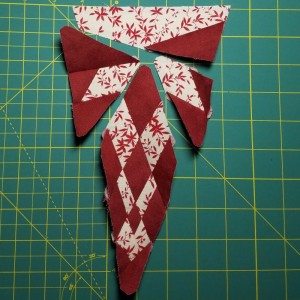
The only real snag was that last triangle-ish shape at the base, which ended up being trickier than intended. There are six pieces coming together at the center of that seam and it was tough to get everything to line up properly. I’m still not 100% pleased with it, but after ripping it out and stitching it a second time, I’ve decided it’s good enough.
One of the advantages of repeating fabrics is that I learned my lesson from the last time I used this particular fabric. This time, I tried to be very careful about not having any red leaves running parallel to the seams, so the red leaves wouldn’t blend in with the red fabric and make it look like the seams were crooked. The disadvantage is that now I can’t blame any crooked seams on leaf placement.
I’m already tired of this fabric, so I think I’ll move on to something else for the next block. There’s still plenty of room to space out the remaining 18 blocks that are slated to use this oft-repeated fabric.
